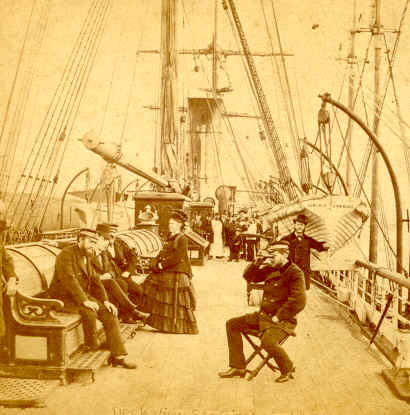Cimbria - 1867
Fleet Number - F-3
Cimbria (German)
Type: Fm
Tonnage: 5000
Length: 325
Beam: 45
Know Your Ships 1968
Tenth Edition
Thomas Manse, Publisher
|
Cimbria - 1867
Fleet Number - F-3 |
|
January 19, 1883 - S.S. Cimbria - German steamer sank in collision with British steamer Sultan in North Sea near Borkum Island, 389 lives lost. - 3,025 tons
The "Cimbria" was built by Caird & Co, Greenock for the Hamburg America Line in 1867. She was a 3,037 gross ton ship, length 339.9ft x beam 40ft, one funnel, two masts (rigged for sail), iron construction, single screw and a speed of 12 knots. There was accommodation for 58-1st, 120-2nd and 500-3rd class passengers. Launched on 21/1/1867, she left Hamburg on her maiden voyage to Southampton and New York on 13/4/1867. On 17/1/1883 she sailed from Hamburg for New York but on 19th Jan. was in collision in dense fog near Borkum Island, Germany with the British vessel "Sultan" of the Hull & Hamburg Line. The Cimbria's hull had a large gash abreast of the foremast and the Sultan also had a large hole foreward and drifted off into the fog.
The Cimbria rapidly sank with the loss of 389 lives and although seven lifeboats got away, only 133 people were saved. [North Atlantic Seaway by N.R.P.Bonsor, vol.1,p.389] [Merchant Fleets in Profile by Duncan Haws, vol.4, Hamburg America Line]

Part of The Fleet
Hamburg-American Packet Company/Packet Company
Formed in 1847, the Packet Company sailed from Hamburg to New York via Southampton. In the early years sailing time was about 40 days, Hamburg to New York. In 1875 the company took over the Adler Line, and in 1886, amalgamated with the Carr-Union Line. They assumed control of the passenger management of Hamburg-South America Line, German East Africa Line and Hansa Line's Canadian service in 1888. The five vessels of the Eagle Line were purchased when that company collapsed and, about 1890, they took over the Hansa Line. In 1930 Hapag Lloyd Union was formed with North German Lloyd, and in 1970, the company combined with North German Lloyd to become Hapag-Lloyd AG.
By 1872 the company was making weekly passages to New York and had extended their service to include Baltimore, the West Indies, Mexico, South American, China, Japan and Australia. Service was extended about 1873 to include routes from Hamburg, Antwerp and Montreal in the summer and Hamburg, Antwerp and Boston in the winter.
To avoid competition in the Mediterranean the Hamburg-American and the North German Lloyd Line agreed to run a joint service in that area. They sailed from Algiers, Naples and Genoa to New York.
Routes - North Atlantic
1847-1939, 1970-1980 Hamburg - New York
1847-1869 Hamburg - Southampton - New York
1856-1939 Hamburg - Quebec - Montreal
1869-1889 Hamburg - Havre - New York - Plymouth - Cherbourg - Hamburg
1869-1932 Hamburg and Cuxhaven - Boston
1889-1939 Hamburg - Baltimore
1889-1939 Hamburg - Southampton (Cherbourg 1895) - New York
1897-1905 Genoa - Naples - New York
1898-1939 Hamburg - Philadelphia
1902-1906 Hamburg - Boulogne - Dover - New York
1902-1939 Passenger sailings from Cuxhaven in place of Hamburg.
![]()
Update:
November 16, 2010
Dear Ted,
Thanks a lot for these wonderful pictures! I liked especially the front of Mr. Bolsters scrap-book. Nostalgic!
As a wreck museum we have quite a pool of interesting objects, found at the sea-bottom in sunken ships. Also, as mentioned from the Cimbria, as she presents one of our most important wrecks. Her collision was one of the biggest disasters within the civil ship history of the German bay. I attach two pictures of our most interesting objects - a cup (quite alike to Mr. Bolster's book) and bottles - both salvaged from the Cimbria's wreck. If you like you can display them on your Homepage, just label them with "Property of the Wrackmuseum Cuxhaven". The sketch shows the Frisia - a ship very alike to the Cimbria, although a bit longer.
As for the Cimbria's fate was so tragic, she is very well known and so there are quite a lot of information and stories to be found in the deep of the WorldWideWeb. It doesn't makes it easier to find reasonable data, but we analysed the minutes of the "Maritime Board of Inquiry" in Hamburg and the original passengers list to get reliable information about the number of persons on board, we like to share with you.
The Cimbria left Hamburg on January 17th with a total number of 493 persons on board. There were 91 crewmen, 1 French pilot from Le Havre and 401 passengers (most from East-Europe). The Cimbria collided in the night of January 19th in the area of Borkum Island with the British ship Sultan (build 1867, 1881 taken over by Bailey & Leetham in Hull together with her former company Gee & Co, Hull. 1903 transferred with her company Bailey & Leetham to the Wilson Line).
As a result of this disaster 437 of Cimbria's 493 persons died and only 56 were rescued by the ships Theta and Diamant (39 survived in lifeboats, 17 in the shrouds of the mast, who's tops were still above sea level after the sinking)
I hope these data are helpful for you.
May I ask you a favour? We would love to display your scan of Bolsters sketch in our new exhibition, properly labelled of course. Would that be ok for you.
Yours,
Katja Tiltmann
Stadt Cuxhaven
8.5 Museen und Stadtarchäologie
Postfach 680
27456 Cuxhaven
Tel: 04721-23341
Fax: 04721-690876